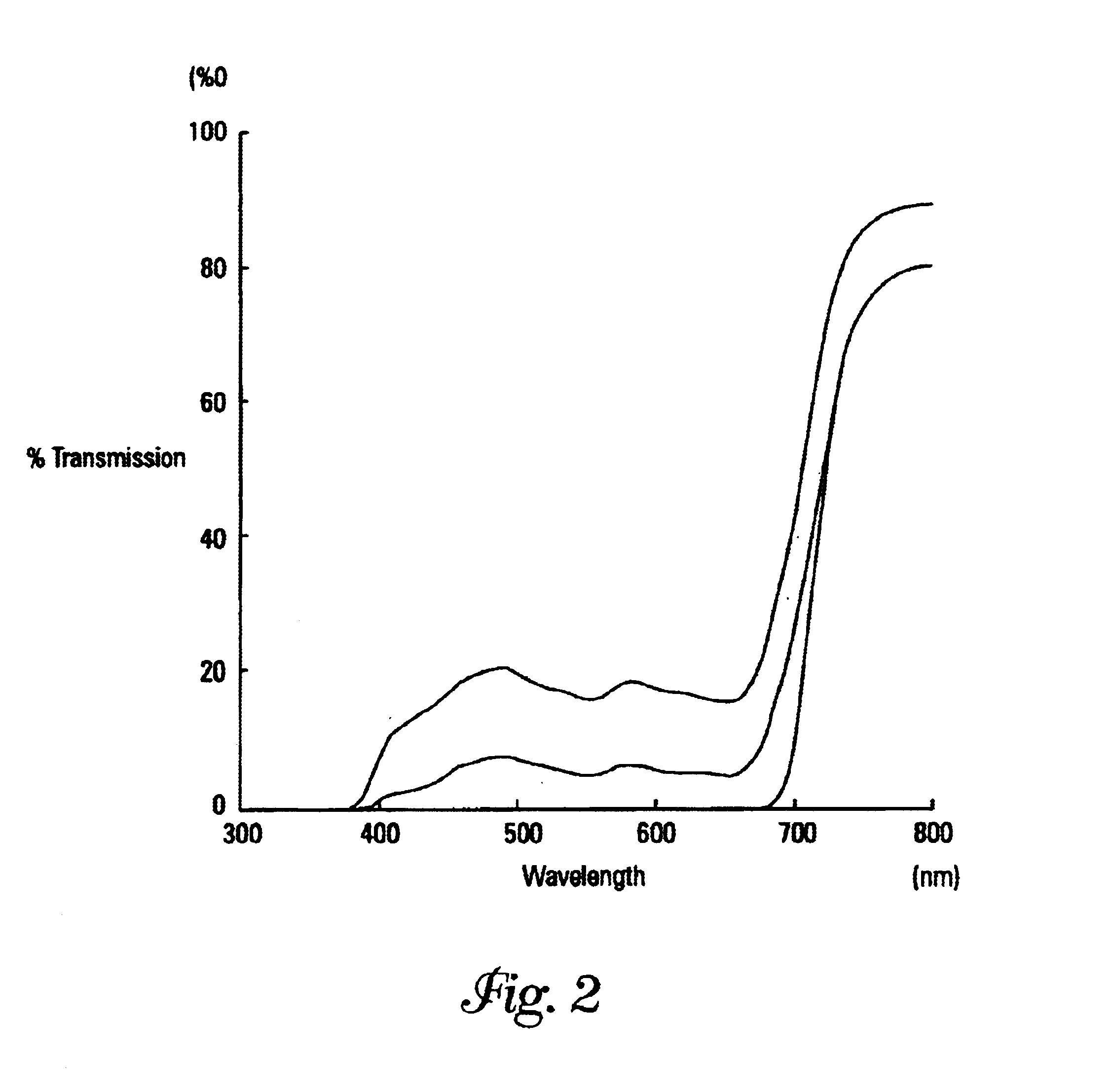Light polarizing film with melanin
a light-polarizing film and melanin technology, applied in the field of polarizing elements, can solve the problems of poorly characterized three-dimensional polymer, amorphous, and high irregularity, and achieve the effects of improving the sensitivity of the light-polarizing film
- Summary
- Abstract
- Description
- Claims
- Application Information
AI Technical Summary
Benefits of technology
Problems solved by technology
Method used
Image
Examples
example 1
A poly(vinyl alcohol) film (Kuraray Vinylon.TM. #7500 film forming polymer) is stretched 3 times while being immersed in a 5 wt. % melanin (aqueous melanin from Photoprotective Technologies) aqueous solution bath at 48.degree. C. for 2.5 minutes. The film is then immersed into 1 liter of dye solution containing 0.5 g of Direct Blue 12 at 41.degree. C. for 50 seconds. The film is slowly stretched to 5 times of its original length during the immersion. The film is then rinsed with water, air dried, and heat treated at 110.degree. C. for 10 minutes while still under tension, to produce a melanin-containing, blue polarizing film.
example 2
A poly(vinyl alcohol) film (Kuraray Vinylon.TM. #7500 film forming polymer) is stretched 2 times while being immersed in a 5 wt. % melanin aqueous solution bath at 49.degree. C. for 4 minutes. It is then immersed in 1 litter of aqueous solution containing 2.5 wt. % of melanin, 0.3 g of Congo Red, 1.9 g of Chicago Sky Blue, and 0.5 g of Direct Yellow (all dyes are available from Aldrich Chemical Company, Milwaukee, Wis.) for 13 minutes at 40.degree. C. The film is transferred into 1-liter acid solution containing 12.0 g of boric acid and 0.6 g of chromium nitrate. It is stretched mono-axially to 6 times of its original length while being kept in the acid solution. The stretched film is rinsed with water, air dried, and heat treated at 110.degree. C. for 10 minutes while still under tension, to produce a melanin-containing blue-gray polarizing film.
The optical properties of the films are listed in Table 1. In the single blue dye case (Example 1 and Comparison example 1), the films sho...
example 3
A polyvinyl alcohol (Kuraray Vinyon.RTM. #7500 film forming polymer) film (75 microns thick) was dyed at 40.degree. C. for 15 minutes in an aqueous solution containing 0.40 g / liter of Chlorantine Fast Red, 0.30 g / liter of Brilliant Blue 6B and 0.30 g / liter of Chrysophenine (three dichroic dyes). The film was subsequently dyed at 40.degree. C. for 15 minutes in an aqueous solution with a pH of 7 containing 1% by weight of Melanin.
The dyed film was immersed for 10 minutes at room temperature in an aqueous solution containing 0.3 g / liter of nickel acetate tetrahydrate and 12.2 g / liter of boric acid at room temperature for 10 minutes, and monoaxially stretched in the same solution to 4 times its original size. It was then taken out of the solution, and while it was maintained under tension, it was washed with water and dried, then heat-treated at 110.degree. C. for 10 minutes to obtain a polarizing film.
The resultant film had a polarizing efficiency of 97% across the visible spectrum.
Fo...
PUM
| Property | Measurement | Unit |
|---|---|---|
| reflectivity | aaaaa | aaaaa |
| reflectivity | aaaaa | aaaaa |
| reflectivity | aaaaa | aaaaa |
Abstract
Description
Claims
Application Information
 Login to View More
Login to View More - R&D
- Intellectual Property
- Life Sciences
- Materials
- Tech Scout
- Unparalleled Data Quality
- Higher Quality Content
- 60% Fewer Hallucinations
Browse by: Latest US Patents, China's latest patents, Technical Efficacy Thesaurus, Application Domain, Technology Topic, Popular Technical Reports.
© 2025 PatSnap. All rights reserved.Legal|Privacy policy|Modern Slavery Act Transparency Statement|Sitemap|About US| Contact US: help@patsnap.com



